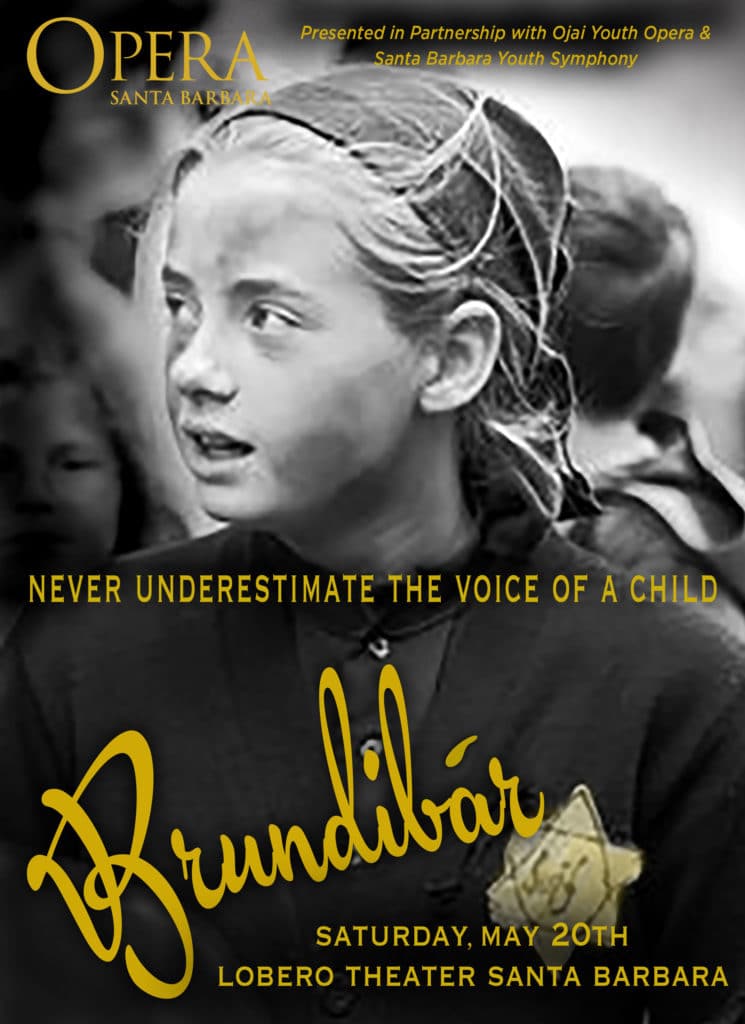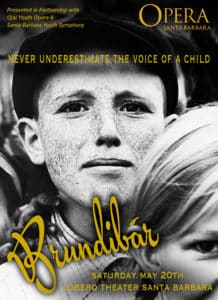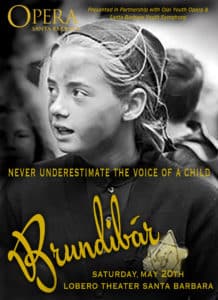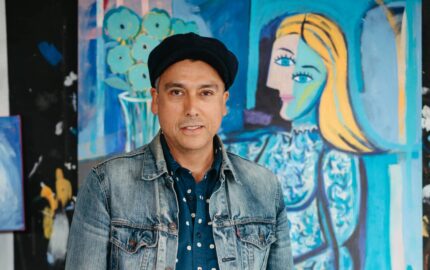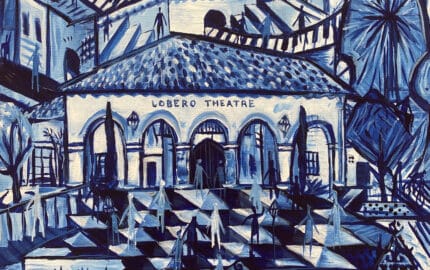What You Should Know:
About Santa Barbara Youth Opera
Rebecca Comerford, Director of Santa Barbara Youth Opera is an accomplished performer at the helm of a very ambitious collaboration with Ojai Youth Opera, Opera Santa Barbara and the Santa Barbara Youth Symphony to bring the youth opera Brundibár to life at the Lobero this spring.
This story is currently featured in the Spring 2017 BACKSTAGE at the Lobero, but we were forced to edit it down for space. We hope you’ll read on to learn more about this powerful work of theater, and the talented team that’s putting it all together. This project is a part of the Lobero Theatre Foundation’s Youth and Community Outreach Programs.
How did you begin working with Opera for youth?
I am a Lyric Mezzo Soprano with a Masters Degree in Vocal Performance/Opera from the Manhattan School of Music. I have sung as a soloist throughout the US and Europe, and while most of the audiences I have sung for have been adults, I have always loved sharing the art form with younger audiences as well. While in New York City, I sang for the Metropolitan Opera Guild, performing outreach education to over 15,000 public school children in underserved areas, which is how I started sharing the operatic art form with youth. I started an Opera Camp at the Brooklyn Conservatory of Music in the summer, where I brought colleagues from New York City Opera and the Metropolitan Opera to do workshops and masterclasses with the children. When I moved to Ojai five years ago with my budding family, I carried on this work as an Artist-in-Residence with the Ojai Music Festival, going into the schools in Ventura County and starting a program called “Ojai Creates Opera.” I then started my own company in Ojai, “Ojai Youth Opera,” where we have been holding masterclasses, workshops and opera scenes for youth ages 7-18 every summer for the past five years. We are bringing a level of excellence in classical music education to the youth of this area and exposing them to a new art form, and the results have been truly rewarding.
There is a reason why this opera survived the war. It makes me feel there is still more insight, more hope, more tolerance, more love that can be spread and shared through this work of art. The children of Theresienstadt will forever be remembered through the voices of our children.
Tell me a little bit about this collaboration with Ojai Youth Opera and the Santa Barbara Youth Symphony for Brunidbár. How did that come together?
Maestro Protopapas had heard about what was happening in Ojai through a mutual colleague at the Santa Barbara Youth Symphony, Director Andy Radford. Maestro had been considering doing a youth production of Brundibár in Santa Barbara as an addition to the regularly scheduled OSB performances for the 2016/2017 season; what he didn’t know initially was that Ojai Youth Opera had also been planning on staging Brundibár in the Spring of 2017 as our first featured Opera! Kostis reached out to me, and we marveled at the serendipity of it all–Brundibár is not a common opera and the chances of us both being drawn to the same material at the same time are quite rare. We decided to co-collaborate and align our vision to make one production that could be performed both at Ojai’s Libbey Bowl and at the Lobero in Santa Barbara in May of 2017. We decided to share our staff, resources, and talent as a truly collaborative effort because all three organizations, Ojai Youth Opera, Opera Santa Barbara and the Santa Barbara Youth Symphony, believe strongly in the message of hope and tolerance that has inspired this opera and we believe it is timely and important to share it.
What can you tell us about the work, Brunidbár?
At its most basic level, Brundibár is a musical fable told from the perspective of a brave brother and sister who are confronted by a larger-than-life organ grinder who bullies and scares them. The animals and townspeople of their small village serve as symbols of resistance and encouragement to help the siblings find their voices and ultimately succeed in standing up to Brundibár, despite being children.
Although the story is simple, its message is anything but. Originally written in 1938, Krasa and librettist Adolf Hoffmeister created the opera for the Children’s Orphanage of Prague. It debuted in secret in 1941, due to the occupation by the German army. When the war escalated, Krasa was deported to Theresienstadt concentration camp and re-wrote the opera, (some of which was destroyed along the way) for the children and instrumentalists in the camp. Overall, Brundibár was performed 55 times by the children of Theresienstadt. Hitler failed to realize was that the opera itself was a work of resistance. The Brundibár character symbolized Hitler himself, a bully and tyrant who would stop at nothing to get his own way, including threatening small children. In this story, the children overcome the tyrant and refuse to be intimidated. The victory chorus at the end of the opera is the ultimate triumph–a defiant plea to not give into hatred, prejudice, and bigotry, sung from the courageous hearts of the children. It is their innocence and hope that prevail, and those qualities are reflected in Krasa’s score.
What do you envision for the future of the Youth Opera program?
Maestro Protopapas has said that soloists come and go, but it is the ensemble, the people who are part of the community and committed to season after season, that are really the lifeblood of the organization. My hope is that the Youth Opera program will also become a musical cornerstone for the opera company, so that year after year, we watch these children return to OSB and mature into polished young artists who become a permanent part of the ensemble. Even if they don’t become professional opera singers or classical musicians, we will be cultivating the next generation of opera aficionados, educators, leaders and advocates in a time when they are so desperately needed. Their presence in the Opera Company can, in turn, ignite a whole new audience–younger, more diverse, and open to new art forms. And in this way, we all grow.
